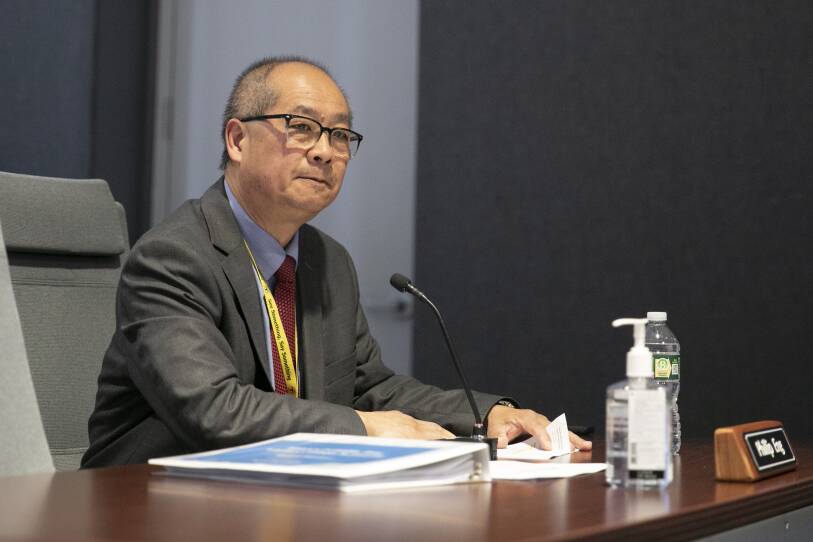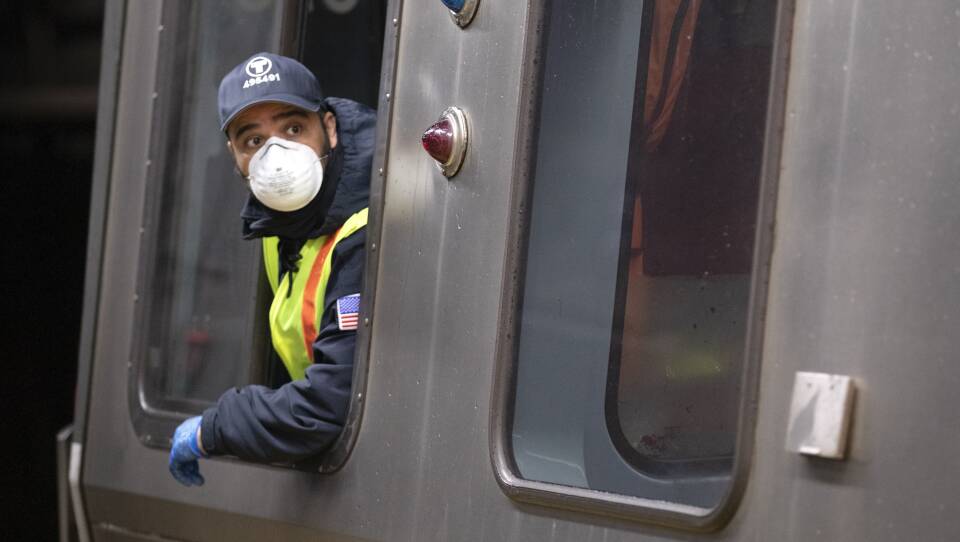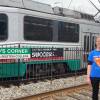The MBTA hopes to restore the entire Blue Line to full-speed operation by November, and officials will end service early on several nights in the next month to accelerate necessary repairs, new T boss Phil Eng said Wednesday.
A bit more than a week into his tenure as general manager, Eng offered an early sketch of the work required to lift slow zones on one of the four subway lines that have been hamstrung by limited speeds due to newly confirmed infrastructure flaws. Plans to fix the problems on the other three lines are still in development.
Eng said the T is aiming to lift all remaining Blue Line speed restrictions "no later than November," which would be eight months after MBTA officials suddenly expanded slow zones across the system .
Eng told the T's Board of Directors that crews in the short term will aim to replace 1,950 feet of rail and 465 rail ties, plus tamp 3,300 feet of track, between Bowdoin and Aquarium stations. That will allow the MBTA to shave the percent of the Blue Line subject to slow zones from 43 percent today to 28 percent by the end of May, speeding up travel and allowing trains to run more frequently.
Officials are exploring ways to "accelerate" the timeline, starting with a batch of evening closures, Eng said. Blue Line trains will stop running around 7 p.m. each night from Monday, April 24 to Thursday, April 27 and from Monday, May 1 to Thursday, May 4.
On those eight nights, shuttle buses will replace trains between Government Center and Wonderland and will not run to Bowdoin. Trains will return at the start of service each morning.
More Politics
It's the latest embrace of a strategy the T has turned to time and time again in recent years: imposing some short-term inconvenience to get critical projects done more quickly.
The traditional overnight schedule provides crews only about two hours to work on the tracks after accounting for preparation and clean-up, Eng said. By shuttering trains starting at 7 p.m., workers get a seven-hour work window overnight.
He said the eight nighttime early closures will help shorten the project duration from six months to one month.
"Reducing the timeframe of that overall work from six months to one month, that allows us now to get onto another line sooner rather than later. The shortening of the trip will allow more trains to pass through, reduce the headways, so incrementally, not only is your trip better, but the trip for the next person is better," Eng told reporters. "This is the strategy laid out for the Blue Line. It will be comparable to the Red Line, Orange Line, Green Line and any other system that we're working on because we've got ourselves to a point where I think — what we've heard today from the public, what I've heard since I started is that they've lost faith, but they need us and they want us to succeed. They are hopeful. And I think this will demonstrate that we have a strategy that will deliver."
Eng told the board that MBTA officials will "make sure that we are fully coordinated with our colleagues" at the Department of Transportation to minimize the Blue Line impact during the summertime closure of the Sumner Tunnel, which like the subway line connects East Boston with the city's downtown hub.
The current Blue Line slow zones cover nearly 5.4 miles of track, adding about 15 minutes of travel time to an end-to-end round trip, Eng said.

Eng's proposed timeline — about a month for some improvements and seven more months to get the Blue Line completely back up to speed — drew criticism from some transit advocates and community leaders.
Kate Dineen, president and CEO of A Better City, called it "unworkable for riders and our region alike."
"While we appreciate the MBTA's prioritization of Blue Line service, this timetable is untenable in light of the transit dependent riders and essential workers that rely on this line each and every day," Dineen said in a statement. "It is imperative to address major track issues before the Sumner Tunnel closure in July and the MBTA must consider alternative strategies that do not require starting to shut down service as early as 7 PM, which would disproportionately impact shift workers as well as the broader economy. Additionally, we need more transparency about what was actually achieved during recent Blue Line closures and what documentation gaps and inconsistencies triggered the systemwide speed restrictions just over a month ago."
It's still not clear how long the Red Line (26 percent slow zones), Orange Line (24 percent slow zones) and Green Line (18 percent slow zones) will continue to run trains below traditional top speeds.
Eng said his team is still crafting plans for those lines and expects to have an announcement about the Red Line "shortly." Data from transit advocacy group TransitMatters estimate the slow zones on the Red Line currently add more than 75 minutes of time to an end-to-end round trip.
"We're working aggressively to be able to provide a full schedule for the full system so everybody, including the board, the public, knows when we're planning to tackle it," Eng said.
Before Eng arrived, the MBTA on March 9 suddenly placed its entire subway system under a slow zone and then shifted to hundreds of individual speed restrictions . Officials said at the time that they ordered slower travel as a precaution because they were unable to confirm whether past inspections and repairs took place, and they kicked off a wide-reaching inspection process to fill in those gaps.
Now, more than a month later, the focus has shifted from missing or incomplete paperwork to addressing significant physical problems with the T's infrastructure.
MBTA officials have not said how the subway tracks got in such poor condition that trains cannot safely run at full speed in many areas, nor have they disclosed why so many defects appear to have gone undetected or unreported before last month.
The T hired Charles O'Reilly of Carlson Transport Consulting to conduct an independent investigation of its track safety inspection procedures, record-keeping and corrective action implementation.
Asked Wednesday if the months-long forecast to lift slow zones on the Blue Line means trains should not have been running at full speed before the early March upheaval, Eng pointed to the ongoing investigation and said he did not want to "speculate on what was occurring in the past."
"What we're going to be doing is tackling those things that are causing issues, tackling those things that led to that for us to get to this point, and then instilling the culture of ensuring we're doing it timely, ensure we're doing it right, and ensure that we are making sure that these repairs are long-lasting," Eng said. "That now then gives us the time to start looking towards the future, planning how we do the larger-scale work that not only improves service for others, but also allows us to be more operationally flexible providing service today."
"So this is the first step of restoring not only service today, but how do we rebuild for the future generations," he added.
Riders continue to face major headaches on the T. In addition to the slow zones that on Wednesday covered nearly one-quarter of the subway system, weekday service on the Red, Orange and Blue Lines remains depleted 10 months after the MBTA rolled out cuts it said at the time would be temporary.
A Green Line train became disabled at Boylston on Marathon Monday, creating massive impacts for the crowds who assembled to watch the historic race or attend the early Red Sox game. Eng said 24 other Type 9 cars like the one that malfunctioned are being inspected.
Appearing at his first MBTA Board of Directors meeting since he took the job, Eng told riders -- several of whom vented criticism at board members and T officials during the public comment period -- he understands their frustration and will work to regain their trust.
"The status quo is unacceptable, right?" Eng told reporters after the meeting while discussing the Blue Line nighttime shutdowns. "If we don't do this work, then we're just going to continue to run slow speeds and continue to delay people, taking away from their time with their family and friends."






